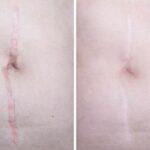Laser treatment of Hemangiomas
Infantile Hemangioma Laser Treatment
Angiomas are more common than they may seem. These are superficial reddish lesions that appear on the skin and are actually formed by an excessive grouping of blood vessels. They are also often called hemangiomas.
It is common to see them in the area of the lips and nose, although in reality, they can appear anywhere on the body. Their size can vary, and in the case of children born with them, it is common for them to disappear on their own with the passage of time.
The appearance of angiomas in adults is somewhat less frequent, but it can occur. The exact cause of its appearance is unknown to this day, although most medical hypotheses suggest that it has a hereditary component. However, this does not imply that if the father or mother has angiomas, their child will have them.
Angiomas may be in turn v types Aryan, depending on the colour of the stain and whether or not the injury is raised as if it were a wart. There are cavernous angiomas, known as strawberry angioma, wine stain angioma (very rare), and nevus flammeus.
Why do hemangiomas appear?
Hemangiomas usually appear during the first six months of life in babies, and although they can appear anywhere on the body, they tend to appear more frequently on the face and eyes.
In most cases the appearance of a hemangioma does not pose any type of problem; most of them lose colour and flatten with the passing of time. In fact, most children with hemangiomas do not have any symptoms by the age of nine.
However, there are cases in which they can be dangerous, such as hemangiomas that appear in the eyelid area, on the surface of the eye or in its orbit, since they can affect the normal development of the eye. Also of particular concern, and should be under medical supervision, are hemangiomas that appear near the nasal passages and the mouth.
Hemangiomas that appear in the skin folds can also cause complications since they can ulcerate. While those hemangiomas that are large can affect the child on a psychological level by damaging his image.
For years hemangiomas were treated with radiation therapy, but it was shown that children who underwent this treatment were later more likely to develop skin cancer. Subsequently, oral corticosteroids were used and in recent times Propranolol has been applied, a drug to treat hypertension that has been shown to give good results in more than 90% of cases.
In the case of flat-type hemangiomas, the application of laser has also proven to give good results as it is especially effective in destroying the small cutaneous capillaries that form the spot without damaging the rest of the skin.
How should we act when they appear?
The first thing we will have to do is go to the paediatrician’s office to confirm what type of injury it is, since, depending on this, the treatment to be followed will be different. Once the diagnosis has been confirmed, we will only have to monitor its evolution and wait for it to naturally disappear on its own.

In those cases in which the angioma is located in a delicate area (close to the eyes, on the lips or nose …), or that hinders the normal development of the child’s basic functions, the paediatrician will recommend its elimination, using the different treatments available that exist for it. Most of the time they are removed with surgery or laser, but at other times they can be treated with intravenous corticosteroids or propanolol.
It will be this specialist who determines, depending on the affected area, its size and its evolution, if it is necessary to act, as well as the treatment that best suits each child.
Laser treatment of angiomas
In the case of children, it is better not to apply any treatment on the angioma in the first four years of life, since many times they remit spontaneously and thus the presence of scars is avoided.
The most common form of treatment for these injuries is laser, although the type of light to be used may vary depending on the type of angioma in question. The most common is to use the neodymium-yag laser and pulsed light.
Before starting the treatment, the dermatologist will examine the angioma and determine the best treatment to follow, determining the laser to be used.
The application of laser does not usually involve any complications, it is not necessary to apply anaesthesia and the patient can return to normal life after the application of pulsed light. Depending on the type of angioma in question and its extension, it may be necessary to apply several sessions.
The laser hits directly on the blood vessels that are causing the stain, causing it to lose colour until it disappears.
For larger angiomas with swelling, the laser may not be entirely effective. In these types of situations, cortisone is usually prescribed to delay the development of an angioma that is in full growth, and it can even be surgically removed




GIPHY App Key not set. Please check settings